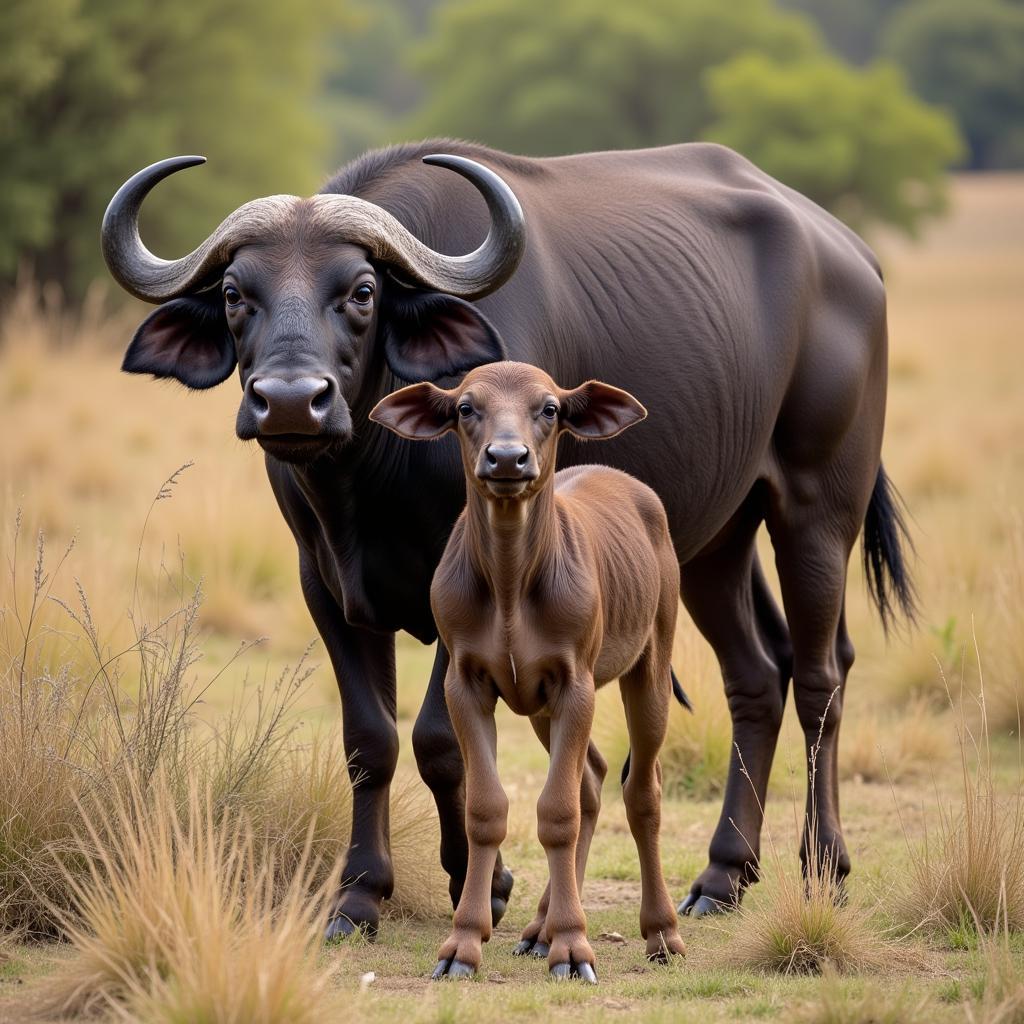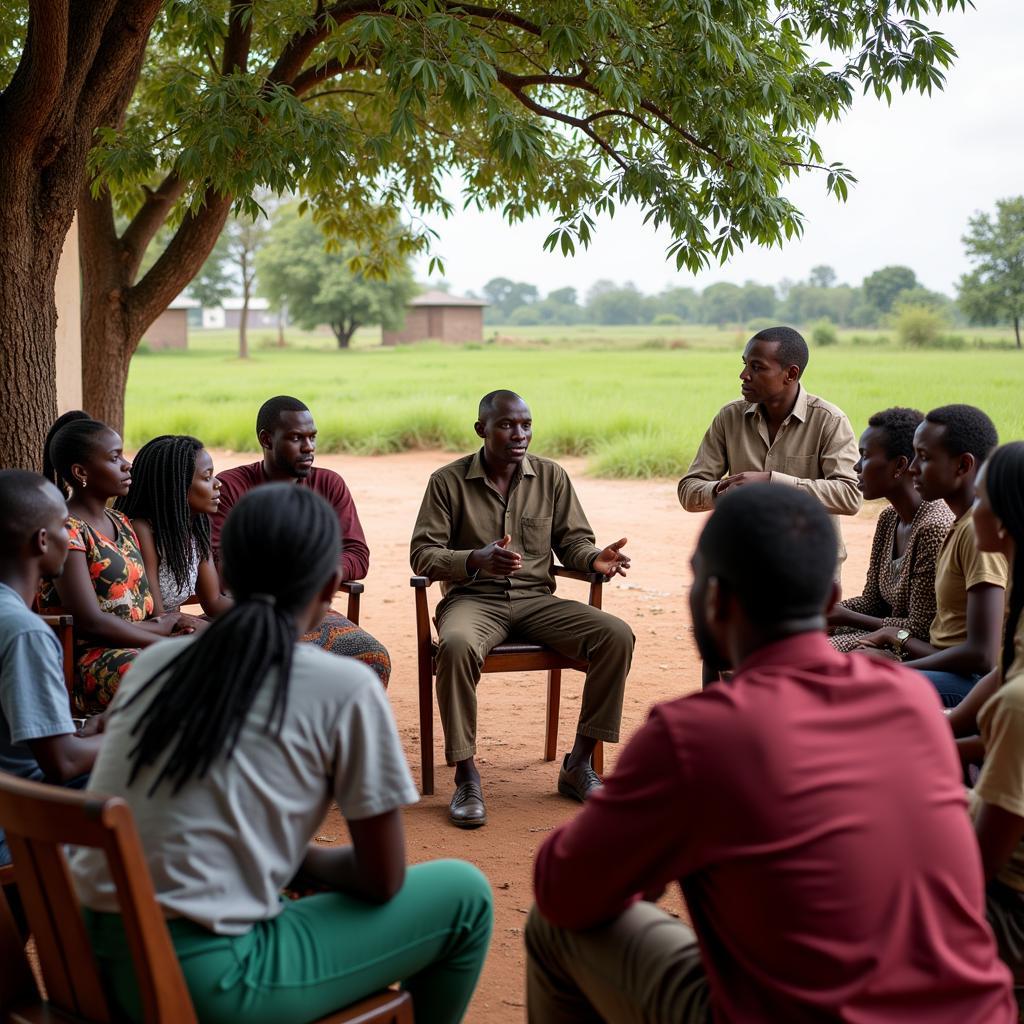Unraveling the African Buffalo Class: Majesty and Might on the Savannah
The African buffalo, an iconic inhabitant of the African savanna, is a creature of immense power and presence. Often described as belonging to the “African Buffalo Class,” these imposing bovids are far more than just large, horned herbivores. They are a keystone species, shaping their ecosystem and captivating wildlife enthusiasts with their complex social structures and raw power.
The African Buffalo: More Than Meets the Eye
While the term “African buffalo class” might conjure images of a taxonomic ranking, it’s more accurate to understand it as a descriptor of the animal’s stature and ecological role. African buffalo (Syncerus caffer) are not classified as a distinct class themselves. They belong to the:
- Kingdom: Animalia
- Phylum: Chordata
- Class: Mammalia
- Order: Artiodactyla
- Family: Bovidae
- Subfamily: Bovinae
- Genus: Syncerus
Within the genus Syncerus, there are recognized subspecies, each with unique characteristics and geographical distribution. These variations add to the fascinating tapestry of the African buffalo.
Mighty and Massive: Physical Characteristics
African buffalo are easily recognizable by their robust build, their distinctive horns, and their characteristic dark brown to black hide.
- Size and Weight: They are one of the largest bovids in Africa. Males, significantly larger than females, can reach shoulder heights of up to 1.7 meters (5.6 feet) and weigh up to 900 kilograms (2,000 pounds).
- Horns: Both males and females possess horns, but those of males are particularly impressive. The horns curve outwards and downwards, forming a distinctive boss (a shield-like structure) over the forehead in mature males. This boss is a formidable weapon and a symbol of age and dominance.
- Social Structure: African buffalo are highly social animals, living in herds that can number from a few dozen to several hundred individuals. The herds consist of females, their calves, and young males. Mature males often form bachelor groups or live solitary lives.
 Close-up of African Buffalo Horns
Close-up of African Buffalo Horns
The Power of the Collective: Social Dynamics
The social structure of the African buffalo is complex and fascinating. Within the herd, a defined hierarchy exists, with older, more experienced females often taking on leadership roles. These matriarchal societies rely on complex communication, including vocalizations, body language, and scent marking, to maintain cohesion and navigate their environment.
- Defense: Their herding behavior is a vital defense mechanism against predators like lions, hyenas, and crocodiles. When threatened, buffalo will form a protective circle around the young and vulnerable, presenting a formidable wall of horns to their attackers.
- Communication: Buffalo communicate through a range of sounds, from low grunts to loud snorts and bellows. These vocalizations convey information about food sources, potential dangers, and social interactions within the herd.
An Integral Part of the Ecosystem
The “African buffalo class,” with its significant grazing impact, plays a crucial role in shaping the savanna ecosystem. They are often referred to as “ecosystem engineers” because:
- Grazing Influence: Their feeding habits influence plant diversity and create habitats for other animals. Their dung also contributes to nutrient cycling, supporting a web of life within the savanna.
- Prey Species: As a primary prey species for large carnivores, they contribute to a healthy predator-prey balance, further influencing the dynamics of the ecosystem.
 African Buffalo Calf with Mother
African Buffalo Calf with Mother
Conservation Status: A Species of Concern
While still relatively widespread across sub-Saharan Africa, African buffalo populations face growing threats.
- Habitat Loss: Habitat loss due to human encroachment, agriculture, and urbanization is a significant concern.
- Disease: Outbreaks of diseases, such as rinderpest and bovine tuberculosis, can devastate buffalo populations.
- Poaching: Poaching for meat and trophies also poses a threat, although buffalo are not as heavily targeted as some other African wildlife.
Conservation efforts are crucial to ensure the long-term survival of these magnificent creatures. Protecting their habitat, managing diseases, and combating poaching are essential to maintaining healthy buffalo populations and the ecological integrity of the African savanna.
Conclusion
The term “African buffalo class” might be a casual way to refer to these animals, but it speaks to their imposing nature and their vital role in the African ecosystem. Understanding their complex social structures, ecological importance, and the threats they face is essential for appreciating and conserving these remarkable animals for generations to come.
FAQs
1. Are African buffalo dangerous to humans?
Yes, African buffalo are considered one of the most dangerous animals in Africa. They are known for their unpredictable behavior and their ability to inflict serious injury with their horns. It’s crucial to observe them from a safe distance and never approach them in the wild.
2. What is the average lifespan of an African buffalo?
The average lifespan of an African buffalo in the wild is around 18-20 years. However, with ideal conditions in captivity, they can live for up to 29 years.
3. What is the difference between an African buffalo and a bison?
Although they share a similar appearance, African buffalo (Syncerus caffer) and American bison (Bison bison) are distinct species. Bison are native to North America and Europe and have a larger hump and shaggier fur. African buffalo have a smoother coat and distinctive horns that form a boss over the forehead in males.
4. Do African buffalo have any natural predators?
Yes, despite their size and strength, African buffalo are preyed upon by large carnivores such as lions, hyenas, leopards, and Nile crocodiles. These predators typically target calves, sick individuals, or isolated buffalo.
5. How can I support African buffalo conservation?
You can support African buffalo conservation by:
- Supporting organizations working to protect their habitat.
- Spreading awareness about the threats they face.
- Choosing sustainable tourism options that prioritize conservation.
For more information on African wildlife and conservation efforts, explore these resources:
Have further questions about African wildlife or the captivating “African buffalo class”? We are here to help! Contact us at:
Phone: +255768904061
Email: kaka.mag@gmail.com
Address: Mbarali DC Mawindi, Kangaga, Tanzania
Our dedicated team is available 24/7 to assist you.
